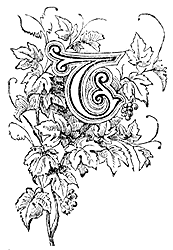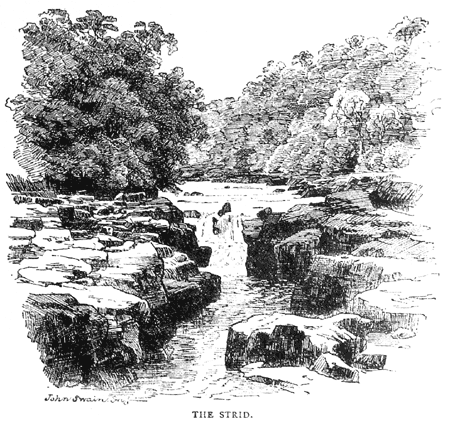 |

HE beautiful remains of this once magnificent priory stand on the Wharf, about six miles from Ilkley, in the West Riding of Yorkshire. The abbey is situated on a curve of the river, but on a level sufficiently high to save it from inundation, should the stream overflow its banks.
Opposite the fine perpendicular eastern window of the church the river falls in a silver line over an almost perpendicular rock of the richest purple colour, up which are twisted in spiral lines the strata of several minerals, broken by some convulsion of nature from their usually horizontal position. To the south extend rich pastures, through which the river glides calmly, reflecting on its tranquil waters the sunlight, and the shadows of the hills.
On the north extends an expanse of turf, spotted with groups of magnificent elm and ash trees, while to the right a wood of ancient oaks is seen, with jutting points of grey rock visible between them. Beyond are the old woods of the priory, and in the distance Simon-seat and Barden Fell - grey and barren - in strong contrast to the softness of the valley beneath.
The Wharf is a most picturesque river; here a waterfall bursts from a woody glen to pour its waters into the stream; there the Wharf is lost to the eye in a deep cleft of the rock, but its solemn roar is heard beneath it - a warning and threatening voice of the waters - for the cleft in the rock above is only four feet wide, and can be and has been leaped by daring travellers, though a false step would be certain death; it is therefore called "The Strid," and to a fatal accident on it the abbey owed its erection.
 A priory had been founded at Embassy, about two miles from Bolton, by William
de Meschines and his wife Cecilia, in 1121, for canons regular of the order of St. Augustine. Its founders at their death left a daughter, who took her mother's name of Romilly, and married William Fitz Duncan, nephew of David, king of Scotland. They had two sons. The elder died young; the younger, "the Boy of Egremont," - so-called, probably, from having been born at Egremont, in Cumberland - was the last hope of his widowed mother.
Out one morning, with his greyhound in the leash, young Romilly, ranging over the moor, came to the chasm and attempted to leap over it; but the greyhound, whose leash he held, hung back, and drew his master with him into the foaming abyss.
The story of the mother's grief and her source of consolation are charmingly told by both Wordsworth arid Rogers.
The latter's poem begins with the following touching lines :-
Wordsworth thus tells the story :
There is another charming legend belonging to Bolton Priory. It is said that not long after the dissolution of the monasteries a white doe appeared every Sunday in the abbey churchyard, remained there during divine service, and left when the congregation quitted the church. The doe came from and returned to Rylstone, the house of the unfortunate Nortons, and this pretty traditional incident suggested to Wordsworth his charming poem, "The White Doe of Rylstone."
The Nortons joined the RISING OF THE NORTH, an ill-organised attempt to put down Protestantism, and restore the Roman Church. Old Master Richard Norton and his nine sons perished in this ill-advised enterprise. Francis - a Protestant, and not concerned in the Rising - was slain, because in obedience to his father he bore back to Bolton Church the banner of the Nortons. Norton's only daughter, Emily, assumed the habit of a pilgrim on the fall of her family, and wandered long in foreign lands. On her return at last to Rylstone she found one faithful friend who recognised her - the white doe.
A lovelier subject for a poem was never devised.
Of the church remains, the tower is of beautiful masonry. Under the window, the tracery of which is exquisite, is this inscription:
Translated into modern English this is
The date should be 1520, for the abbey was dissolved in 1539. Prior Moone was engaged about the tower in 1520, and left it incomplete. Upon a buttress on the south of the tower is a statue of a pilgrim holding a staff in his right hand, and a round shield on his arm.
Beneath it is an old sun-dial. Upon the north and west are hounds.
The original West front is very fine, and has been well preserved. The great height
of the building is very striking; it is 55 feet high, 88 feet 6 inches long, and 47 feet 10 inches wide, the aisle being 16 feet.
The style of architecture of the nave is Early English.
"The windows on the south, with a triforium or wall passage along the base of the lights, are filled with Munich glass, representing in thirty-six groups the life of our Lord, from the Annunciation to the Ascension. The easternmost of the six bears the inscription: 'These windows were placed by order of William Spencer, Duke of Devonshire, 1853 - 4.' There is still in the south wall a narrow staircase from the triforium to the recess above. A staircase also communicates with the base of the west window from the recess." - From the Rev. A. P. Howe's "Guide to Bolton Abbey."
The north aisle is divided from the nave by pillars alternately round and octagonal; the windows have in them still a few remains of the thirteenth century glass.
There is a clerestory of four single and plain lancet windows.
The organ was given by the Duke of Devonshire in 1880, in memory of Mr. Cottingham, his steward for the Bolton and Chatsworth estates for many years. The vestry in which it stands is enclosed by a perpendicular oak screen. On the outside of it, near the organ, is an Agnus Dei in stone, very well carved; it was found in excavating. There is a vault below the organ.
Little remains, except broken ruins and foundations, of the old priory; an ash grows out of the centre of what was the chapterhouse.
A memorial cross has been erected in Bolton churchyard by the tenantry of the Bolton Abbey estates, to the memory of Lord Frederick Cavendish, who was so cruelly murdered when attempting to defend Mr. Bourke, in Phoenix Park, Dublin.
It is a light and very elegant structure.
The Cavendish Memorial Fountain was erected by the electors of the West Riding of Yorkshire, to the memory of their regretted representative, Lord Frederick Cavendish, as an inscription, with the dates of his birth and death, under the cornice above the arches, states.
|
 |